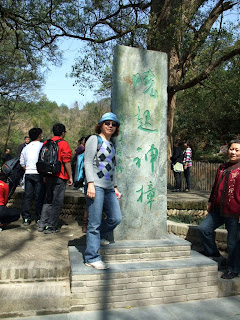
The 50 villages at Wuyuan (婺源) are places on earth where time stand still. Likeng, at the east route scenic spot, 12 km away from Wuyuan County, is an ancient village of more than thousand years with history traced back to North Song dynasty. Emperor Qianlong of Qing Dynasty visited eight times during his reign. It preserved a wonderful building style of Hui architecture and living style of Huizhou culture. Most of the residents were under family name of Li. The village is a hot tourist destination to explore for idyllic landscape and precious cultural legacy.



The stone carved archway proudly erected under the sun after the entrance gate. This impressive old village was built around several creeks that intersect each other.






Village of Likeng lies along the river with green farmland and yellow rape seed flower field, offering beautiful spring scenery of the countryside.


Floating bamboo rafts on the creek appeared like a Chinese landscape painting in poetic flavor.



Small and simple souvenir stores were built with bamboo and set along the stream, selling most of its local made products, like ink-slab, wood and stone carving, camphor wood piece etc.


The mini waterfall from the little creek just in front of the bamboo built stores.


Placing the camphor wood in the cupboards, book shelves or suitcases to avoid worms and inserts is still practiced nowadays. The local lady was sawing the camphor tree trunk into small pieces for sale.


An ancient water mill for hulling grain which was still in use today.


The little old Buddhist Temple was sustained by doing blessing for tourists to receive some donations from them. The blessed red ribbon was placed at the huge image of Boddhisattva Maitreya in front of the temple.



Vast horizon of yellow rape seed flower farm.



The side and front view of Hexagon Pavilion through its windows.



The Pavilion marks high literacy of the place. It was recorded that in the past, there were thousands of Wuyuan residents passed the ancient Civil Imperial Examination and hold the post as an officer in the imperial court. The Civil Examination was abolished in Qing Dynasty in year 1905 after being practiced for 1300 years.



The scale chart indicated the status of all imperial officers, the color and design of attire and hat the imperial officers wore during Mind Dynasty.



Being situated on the river, Likeng has many tight and narrow alleyways.



Most of the houses were with white painted walls and grey roofing tiles.


The charm of Likeng is its gentle rural scenery and long historical cultural heritage.


Dwellings seated against hills and along rivers with cross paved stone roads wandering from house to house. Streams wind through the village with wooden, stone or brick bridges crossing over and connecting to both banks.


Some of the ancient houses had been converted into hotel, restaurants and tea houses.



Travelers were offered with a moment of relaxation and stress free hour away from the hustling world.


Ancient architectures of Ming and Qing Dynasty are all around the village of Likeng.


Villagers kept the heritage and carried on olden ways of living refusing the urbanization encouraged at this 21st century.


Without much influences from modernization, the village retains its classical beauty and traditional life style.


Li-shi Restaurant surrounded in building structures of Hui Architectural style.


Shop selling home made healthy five grain soy milk at rmb5.00 per cup at the alleyway.



The mansion that was built within 1851-1861 during Qing Dynasty, belonged to a government officer named Li Wen-jin.


Admiring the exquisite workmanship of the stone, wood and brick carvings at the entrance gate and hall. They were distinctive.




The local hand made snack made from maltose and the unique pork-belly liked stone.


Village Xiaoqi sits on a lovely riverside perch, dating back to 787 BC.


The house was built during the reign of Emperor Guangxu in Qing Dynasty. It belonged to a successful businessman named Wang Yunzhang who was in the trade of tea leaves at that time. The building was in Qing architecture with exclusive stone carving and engraving at the entrance door. Each image had its own meaning reflecting the superstition of olden days.



Most of the houses were typically constructed with a rectangular openings in the roof to let in natural sunlight and rain. The rain water ran down from conduit was pooled between the stone-slabs below. The example of a rain water conduit to receive and direct the rain water to the stone slabs or sometimes a pool below.



Bai Ren-Tang built in year 1387 was most probably the oldest and superstitious house in China.



Home made rice wine and green barley dumplings are very popular within villagers.


View of Xiaoqi Village and the beautiful roofing of its Jinwu Long Corridor.


The Exuberant Camphor trees in which some is over hundreds or thousands of age.




Wide areas of tea leaves farm and camphor trees at Xiaoqi Village.


For the one hour journey traveling back to Huangshan city, we enjoyed the scenic mountains which were entirely covered with terraces of yellow rape seed flower, bright and soothing!










No comments:
Post a Comment